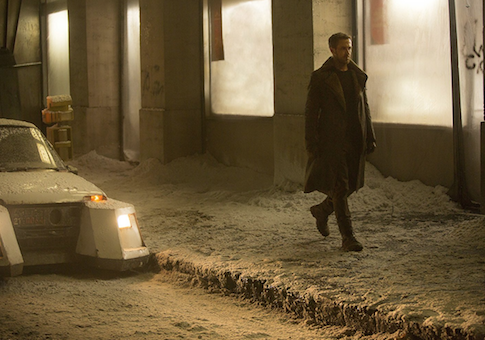Anti-spoiler warning: This piece does not discuss plot points from the film because the studio has asked us in greatly specific detail not to discuss plot points from the film, including the revelation that [redacted] is [redacted] while [really redacted] is actually [super redacted] and the whole thing revolves around [redacted omg redacted].
I was torn heading into Blade Runner 2049.
As someone who has held onto an HD-DVD player solely so I can re-watch my 25th anniversary set of Blade Runner—The Final Cut, obviously—once or twice a year, I'm square in the sights of every marketing executive who thought a sequel to Blade Runner was not only a good idea but one worth spending nearly $300 million on, after marketing. But as someone who loves re-watching the first film because of its thematic inscrutability and the ambiguity of its conclusion, I was also rather firmly in the part of the Venn Diagram circle labeled "No Sequel, Ever, For Any Reason."
Blade Runner 2049 is by no means a perfect film. It's overstuffed with settings and notions and concepts, picking up and dropping threads in an almost haphazard way. It holds the audience's hand while walking through the various psychological and philosophical gambits it is deploying. But it is nevertheless a film, like the replicants who populate it, that makes a perfectly compelling case for its own existence.
A large portion of the defense's brief involves director Denis Villeneuve and cinematographer Roger Deakins creation of a visually compelling world, one that expands upon the landscape built by Ridley Scott in the original film. The dreary, dark acid rain of Scott's 1982 classic has been complemented by a variety of additional palettes 30 years later.
There's the dirty white-grey snow that falls in thick clumps around K (Ryan Gosling), a Blade Runner chasing down advanced versions of the human-like replicants we know and fear and love. There's a murky tangerine-orange on K's journey of self-discovery through the desert of the real, serving as a sort of backlight while he battles with those who would prematurely retire him. There's a pink hue thrown off by garish neon advertisements of nude, female Pinocchios with black holes where their eyes should be beg their would-be customers—consumers too impoverished to afford families, too cut off emotionally to forge bonds—to make them real girls.
If nothing else, Villeneuve's journey through the ruined world of our near future is conducted with the expert hand of a safari guide who understands just how fast to take his wards into the heart of darkness. Despite its 163-minute running time, Blade Runner 2049 never lags. The combination of a rather orthodox detective story—convoluted but rarely complex, Blade Runner 2049 involves K's attempt to solve a murder in addition to committing a few of his own—and luscious vistas keeps the mind engaged while the eye never feels tempted to drift down to one's phone for a quick peek at the time.
Blade Runner 2049 has grand philosophical ambitions, and this may be where it most noticeably falters. Whereas its predecessor toyed coyly with ideas about what it means to be human—or if humanity, per se, was a distinction worth making in an era when men could play God—2049 is rather forward. Villeneuve and screenwriters Hampton Fancher and Michael Green relentlessly drive home their points, hammer away at their message, pick up and drag along those who may not quite be keeping up.
One wonders if that straightforwardness, in combination with the plot's simplicity underneath its veneer of complexity, will diminish Blade Runner 2049 on repeat viewings. Then again, that may not matter. After all, no one knows what will endure and what will be lost, gone forever, like tears in …
Well, you know.
